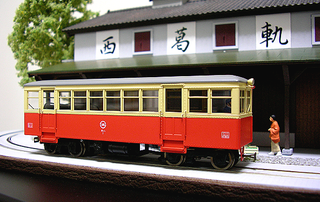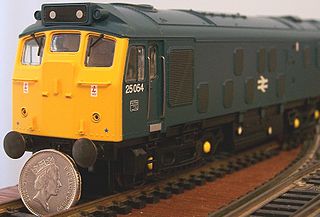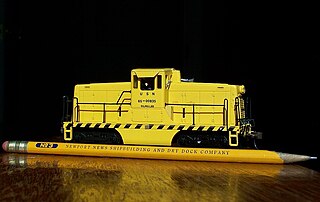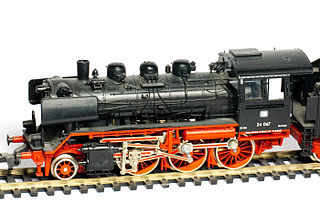This article needs additional citations for verification .(January 2021) |

The use of a third rail in rail transport modelling is a technique that was once applied, in order to facilitate easier wiring. [1]
This article needs additional citations for verification .(January 2021) |

The use of a third rail in rail transport modelling is a technique that was once applied, in order to facilitate easier wiring. [1]
Pre-war train sets from makers such as Hornby were almost entirely O gauge, either clockwork or electric, with the electric sets using a three rail system. Both the track and rolling stock were made from pressed, lithographed tinplate, with a few pieces of die-cast zinc or turned brass. The third rail was insulated from the tinplate sleepers by insulating fibre washers.
Post-war, [lower-roman 1] there was a shift from O gauge to half-size scales of HO and OO. Improved technology at this time, particularly for moulded plastic components, made two-rail electrification practical. Many of the new generation of scenic railway modellers scratch-built their new locomotives for two-rail, although this was far from universally accepted. [2] Most of the commercial train set makers continued with three-rail systems for some time.
Using a two-rail electrification system for a model railway has a number of difficulties, for both track and rolling stock.
Track obviously requires the two rails to be insulated from each other, and from the trackbed, if that is made of metal. If the track pieces are reversible, both rails must be insulated. Reliable running also requires accurate control of the track's gauge, all of which needed accurately injection-moulded plastic fittings, rather than the flexible fibre.
Pointwork was a further problem, as the frog and moving blades are connected to opposite rails, according to which direction in which the points are set. This requires either an insulated two-part frog, with the risk of poor contact to locomotives crossing it; or else an all-metal 'live' frog which must be insulated from the rails beyond the pointwork, and which usually requires an additional switch to give a reliable connection. In comparison, the three-rail system is simply isolated from the running lines.
Some layouts, such as a balloon loop, also create problems for two-rail, as they connect the opposing rails together around the loop and could require isolation.
Carriages and wagons can use moulded plastic wheelsets, which are compatible with both three- and two-rail systems. Hornby Dublo introduced these in 1959, during their transition to two rail, when most users were still using three-rail layouts.
A two-rail locomotive must both avoid shorting the two running rails, and must also collect current from both sides independently. For a three-rail locomotive the wheels and axles are typically metal and the metal chassis may be used as a ground connection. This has the advantage that all wheels, including bogies, act as pickups. This gives a long collection length, reducing the problem of crossing supply gaps.
For two-rail, current collection is typically done by phosphor bronze spring strip collectors on the back of the wheel rims. [3] If the wheels are insulated by using plastic wheels in metal rims, only the rim is available to a collector. Only those wheels, often two, with collector springs can collect current from the track. This can give problems for crossing gaps in pointwork. An alternative system is 'split frame' construction, which had some popularity for the early narrow gauges, such as N gauge and the modelling of narrow gauge prototypes. This uses conductive metal wheels and axles, where the axles are split in half as two sides, insulated from each other. The locomotive frames are split likewise. Rather than separate pickup springs, the axle bearings are used as the collectors. This technique is somewhat complicated for making the axles, but adapts more easily to narrower gauges. It can also easily collect current from all of the driving wheels, or even pony truck wheels too. [4]

Early toy trains used two metal rail tracks like most real trains. However, manufacturers quickly found that using a center rail for electric power and the two outer rails for common or ground made electrical contact much more reliable and less prone to short circuits. Three rail contact also negates the need for insulated wheels, an important consideration before plastics became widely available. Most scales and gauges that predate H0 scale used three rails for electric operation.
Three-rail DC locomotives will move in the same direction, 'forwards', whenever the third rail has the same polarity, no matter which way round they are placed on the track. Two identical locomotives can move in different directions on the track, depending on which orientation they are placed on it.
In contrast, two-rail locos will move in the same direction relative to the track. If the loco is reversed, it will still move in the same (track-relative) direction. By convention, all locos are wired and geared to move consistently, so that double-heading trains is possible.
The Marklin stud contact system uses AC motors. These are independent of the supply polarity and instead use an internal switch, controlled by a higher-voltage pulse to reverse direction.

A key advantage for three-rail track is balloon loops, where a train enters a loop through a turnout and then exits through the same turnout in order to change the train's direction. With two-rail track, when the track reverses on itself, this causes a short circuit. With three-rail track, because the center rail remains constant and the outer rails are electrically identical, this causes no problems.
The third rail has also been used to automate and animate layouts. An accessory, such as a railway signal, can be wired to a section of track that has had one of its outer rails insulated (not grounded), either at the factory or by a hobbyist. A passing train then grounds the insulated rail, completing the circuit and causing the accessory to operate.
Insulated rails (or rail sections) can also be used to control turnouts, causing the turnout to switch to the position needed by an oncoming train.
Because of this feature, railroad cars intended for three-rail operation will not work on two-rail track unless their wheels are first insulated from each other. Cars intended for two-rail track will operate on three-rail track, but they will not activate controls wired to an insulated rail. Conversion of three-rail cars for two-rail operation, or vice versa, is thus a common practice among hobbyists. It requires either replacing the bogies (wheel assemblies) on the car, or replacing metal axles with axles made of a non-conductive material.
The main disadvantage of three-rail track is its lack of realism. While some real-world trains do use a third rail, the prototypes for the majority of model railroad operations do not. Lionel tried to improve this situation in the late 1950s with its Super O track, which blackened the middle rail and made it thinner to reduce its visibility. Other O scale manufacturers use similar techniques today.

Märklin uses a "phantom" third rail, where the middle rail is concealed in the track ballast or ties, with only studs protruding, giving the advantages of three-rail operation without seriously detracting from its realism. This is stud contact electrification for model railways [5] and is often used on garden railway systems. Garden railways often have a mixture of electrical and real steam locomotives, and while it is possible, insulating model steam locomotives to run on two rail electrification systems is problematic. In practice the stud system outdoors has been found to be more resistant to continuity problems caused by the outdoor environment.
Although most three-rail systems ties the two outer rails together electrically, some manufacturers wire all three rails independently. GarGraves is a North American manufacturer of O gauge three-rail track with all of its rails insulated. Trix Express is a European manufacturer of three-rail track who insulates all three rails.
On a simple, non-computerised layout only one train can run independently on either a two or three-rail system (two trains if combined with overhead lines). On the insulated three-rail type, two trains can run independently (three trains if combined with overhead lines).
In the early days of railway modeling, some O scale modelers (the dominant scale at the time), made use of an outside third rail and a shoe pickup system for power. This system had the benefit of being more realistic by removing the central third rail common to O scale track, while retaining an effective power source. As technology progressed, later developments in locomotive and track design would allow for two rail operation, and ultimately rendered the practice obsolete.

Railway modelling or model railroading is a hobby in which rail transport systems are modelled at a reduced scale.

A rack railway is a steep grade railway with a toothed rack rail, usually between the running rails. The trains are fitted with one or more cog wheels or pinions that mesh with this rack rail. This allows the trains to operate on steep grades above 10%, which is the maximum for friction-based rail. Most rack railways are mountain railways, although a few are transit railways or tramways built to overcome a steep gradient in an urban environment.

OO gauge or OO scale is the most popular standard gauge model railway standard in the United Kingdom, outside of which it is virtually unknown. OO gauge is one of several 4 mm-scale standards, and the only one to be marketed by major manufacturers. The OO track gauge of 16.5 mm corresponds to prototypical gauge of 4 ft 1+1⁄2 in, rather than 4 ft 8+1⁄2 in standard gauge. However, since the 1960s, other gauges in the same scale have arisen—18.2 mm (EM) and 18.83 mm (Scalefour)—to reflect the desire of some modellers for greater scale accuracy.

A railroad switch (AE), turnout, or [set of] points (CE) is a mechanical installation enabling railway trains to be guided from one track to another, such as at a railway junction or where a spur or siding branches off.

A third rail, also known as a live rail, electric rail or conductor rail, is a method of providing electric power to a railway locomotive or train, through a semi-continuous rigid conductor placed alongside or between the rails of a railway track. It is used typically in a mass transit or rapid transit system, which has alignments in its own corridors, fully or almost fully segregated from the outside environment. Third-rail systems are usually supplied from direct current electricity.

O scale is a scale commonly used for toy trains and rail transport modelling. Introduced by German toy manufacturer Märklin around 1900, by the 1930s three-rail alternating current O gauge was the most common model railroad scale in the United States and remained so until the early 1960s. In Europe, its popularity declined before World War II due to the introduction of smaller scales.

HO or H0 is a rail transport modelling scale using a 1:87 scale. It is the most popular scale of model railway in the world. The rails are spaced 16.5 millimetres (0.650 in) apart for modelling 1,435 mm standard gauge tracks and trains in HO.

N scale is a popular model railway scale. Depending upon the manufacturer, the scale ranges from 1:148 to 1:160. Effectively the scale is 1:159, 9 mm to 1,435 mm, which is the width of standard gauge railway. However the scale may vary to simulate wide or narrow gauge rail. In all cases, the gauge is 9 mm or 0.354 in. The term N gauge refers to the track dimensions, but in the United Kingdom in particular British N gauge refers to a 1:148 scale with 1:160 track gauge modelling. The terms N scale and N gauge are often inaccurately used interchangeably, as scale is defined as ratio or proportion of the model, and gauge only as a distance between rails. The scale 1:148 defines the rail-to-rail gauge equal to 9 mm exactly, so when calculating the rail or track use 1:160 and for engines and car wheel base use 1:148.

Gebr. Märklin & Cie. GmbH or Märklin is a German toy company. The company was founded in 1859 and is based at Göppingen in Baden-Württemberg. Although it originally specialised in doll house accessories, today it is best known for model railways and technical toys. In some parts of Germany and in Sweden, the company's name is almost synonymous with model railways.

A toy train is a toy that represents a train. It is distinguished from a model train by an emphasis on low cost and durability, rather than scale modeling. A toy train can be as simple as a toy that can run on a track, or it might be operated by electricity, clockwork or live steam. It is typically constructed from wood, plastic or metal. Many of today's steam trains might be considered as real ones as well, providing they are not strictly scale or not enough detailed ones in favor of a robustness appropriate for children or an inexpensive production.
Hornby Railways is a British-owned model railways manufacturing company. Its roots date back to 1901 in Liverpool, when founder Frank Hornby received a patent for his Meccano construction toy. The first clockwork train was produced in 1920. In 1938, Hornby launched its first OO gauge train. In 1964, Hornby and Meccano were bought by their competitor, Tri-ang, and sold when Tri-ang went into receivership. Hornby Railways became independent again in the 1980s, and became listed on the London Stock Exchange, but due to financial troubles reported in June 2017, became majority owned by British turnaround specialist Phoenix Asset Management.

4 mm scale is the most popular model railway scale used in the United Kingdom. The term refers to the use of 4 millimeters on the model equating to a distance of 1 foot (305 mm) on the prototype (1:76.2). It is also used for military modelling.

A track circuit is an electrical device used to prove the absence of a train on rail tracks to signallers and control relevant signals. An alternative to track circuits are axle counters.

Lego Trains is a product range and theme of the construction toy Lego, which incorporates buildable train sets. The Lego Trains theme became a sub-theme of Lego City in 2006. Products in the range have included locomotives, tracks, rolling stock, stations, signal boxes, and other track-side buildings and accessories. The theme is popular among adult fans, as well as children, and has spawned international associations and conventions. The train system is sometimes referred to as 'L-gauge' among Lego fans, in reference to traditional model railway scales. Lego trains use a nominal gauge of 37.5 mm, based on 5-stud track centerlines gauge, corresponding with a circa 1:38 scale.

An axle counter is a system used in railway signalling to detect the clear or occupied status of a section of track between two points. The system generally consists of a wheel sensor and an evaluation unit for counting the axles of the train both into and out of the section. They are often used to replace a track circuit.

A variable gauge system allows railway vehicles in a train to travel across a break of gauge between two railway networks with different track gauges. For through operation, a train must be equipped with special bogies holding variable gauge wheelsets which contain a variable gauge axle (VGA).

Fleischmann is a German manufacturer of model railway products. Fleischmann was founded in Nuremberg in 1887 by Jean Fleischmann, as a toy company. Their first model train, in O scale, was produced in 1938. Their first H0 scale products were introduced in 1952 and their N scale "Piccolo" product line in 1969.

Trix is a German company that originally made Trix metal construction sets. One of its co-founders was Stephan Bing, the son of the pioneer toy-maker industrialist Ignaz Bing. In 1935 the company began producing the electrically powered model trains that it became famous for, under the Trix Express label. Prior to the outbreak of World War II the company produced a small range of AC powered three rail loco models running on bakelite rails.
The stud contact system is an obsolete ground-level power supply system for electric trams. Power supply studs were set in the road at intervals and connected to a buried electric cable by switches operated by magnets on the tramcars. Current was collected from the studs by a "skate" or "ski collector" under the tramcar. The system was popular for a while in the early 1900s but soon fell out of favour because of the unreliability of the magnetic switches, largely due to friction and rapid corrosion affecting its cast iron moving components.
Digital model railway control systems are an alternative to control a layout and simplify the wiring and add more flexibility in operations. A number of control systems are available to operate locomotives on model railways. Analog systems where the speed and the direction of a train is controlled by adjusting the voltage on the track are still popular while they have recently given way to control systems based on computer technology.
{{cite book}}: CS1 maint: multiple names: authors list (link)